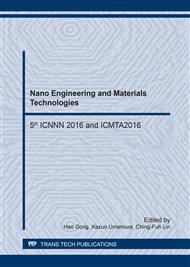[1]
N. Deogratias, M. Ji, Y. Zhang, J. Liu, J. Zhang, and H. Zhu, Core@ shell sub-ten-nanometer noble metal nanoparticles with a controllable thin Pt shell and their catalytic activity towards oxygen reduction, Nano Research, vol. 8, pp.271-280, (2015).
DOI: 10.1007/s12274-014-0664-z
Google Scholar
[2]
H. Liu, F. Ye, Q. Yao, H. Cao, J. Xie, J. Y. Lee, and J. Yang, Stellated Ag-Pt bimetallic nanoparticles: An effective platform for catalytic activity tuning, Scientific reports, vol. 4, (2014).
DOI: 10.1038/srep03969
Google Scholar
[3]
E. Gharibshahi and E. Saion, Influence of dose on particle size and optical properties of colloidal platinum nanoparticles, International journal of molecular sciences, vol. 13, pp.14723-14741, (2012).
DOI: 10.3390/ijms131114723
Google Scholar
[4]
D. McNally, M. Agnello, B. Pastore, J. R. Applegate, E. Westphal, and S. D. Bakrania, A Study of Fuel and Reactor Design for Platinum Nanoparticle Catalyzed Microreactors, Journal of Nanomaterials, vol. 2015, (2015).
DOI: 10.1155/2015/538752
Google Scholar
[5]
C. -L. Sun, J. -S. Su, S. -Y. Lai, and Y. -J. Lu, Size Effects of Pt Nanoparticle/Graphene Composite Materials on the Electrochemical Sensing of Hydrogen Peroxide, Journal of Nanomaterials, vol. 2015, (2015).
DOI: 10.1155/2015/861061
Google Scholar
[6]
A. Chen and P. Holt-Hindle, Platinum-based nanostructured materials: synthesis, properties, and applications, Chem. Rev, vol. 110, pp.3767-3804, (2010).
DOI: 10.1021/cr9003902
Google Scholar
[7]
S. Hoshika, F. Nagano, T. Tanaka, T. Ikeda, T. Wada, K. Asakura, K. Koshiro, D. Selimovic, Y. Miyamoto, and S. Sidhu, Effect of application time of colloidal platinum nanoparticles on the microtensile bond strength to dentin, Dental materials journal, vol. 29, pp.682-689, (2010).
DOI: 10.4012/dmj.2009-125
Google Scholar
[8]
J. Xie, S. Wang, L. Aryasomayajula, and V. Varadan, Platinum decorated carbon nanotubes for highly sensitive amperometric glucose sensing, Nanotechnology, vol. 18, p.065503, (2007).
DOI: 10.1088/0957-4484/18/6/065503
Google Scholar
[9]
L. Liu, P. Miao, Y. Xu, Z. Tian, Z. Zou, and G. Li, Study of Pt/TiO 2 nanocomposite for cancer-cell treatment, Journal of Photochemistry and Photobiology B: Biology, vol. 98, pp.207-210, (2010).
DOI: 10.1016/j.jphotobiol.2010.01.005
Google Scholar
[10]
S. Chowdhury, F. Yusof, W. W. A. W. Salim, N. Sulaiman, and M. O. Faruck, An overview of drug delivery vehicles for cancer treatment: Nanocarriers and nanoparticles including photovoltaic nanoparticles, Journal of Photochemistry and Photobiology B: Biology, vol. 164, pp.151-159, (2016).
DOI: 10.1016/j.jphotobiol.2016.09.013
Google Scholar
[11]
L. Liu, P. Miao, Y. Xu, Z. Tian, Z. Zou, and G. Li, Study of Pt/TiO< sub> 2</sub> nanocomposite for cancer-cell treatment, Journal of Photochemistry and Photobiology B: Biology, vol. 98, pp.207-210, (2010).
DOI: 10.1016/j.jphotobiol.2010.01.005
Google Scholar
[12]
J. Xu, Z. -D. Chen, Y. Sun, C. -M. Chen, and Z. -Y. Jiang, Photocatalytic killing effect of gold-doped TiO2 nanocomposites on human colon carcinoma LoVo cells, Acta Chimica Sinica, vol. 66, pp.1163-1167, (2008).
Google Scholar
[13]
A. T. N. Dao, D. M. Mott, K. Higashimine, and S. Maenosono, Enhanced electronic properties of Pt@ Ag heterostructured nanoparticles, Sensors, vol. 13, pp.7813-7826, (2013).
DOI: 10.3390/s130607813
Google Scholar
[14]
C. Wang, N. M. Markovic, and V. R. Stamenkovic, Advanced platinum alloy electrocatalysts for the oxygen reduction reaction, Acs Catalysis, vol. 2, pp.891-898, (2012).
DOI: 10.1021/cs3000792
Google Scholar
[15]
H. Liu and J. Yang, Bimetallic Ag–hollow Pt heterodimers via inside-out migration of Ag in core–shell Ag–Pt nanoparticles at elevated temperature, Journal of Materials Chemistry A, vol. 2, pp.7075-7081, (2014).
DOI: 10.1039/c4ta00243a
Google Scholar
[16]
S. Chowdhury, F. Yusof, M. O. Faruck, and N. Sulaiman, Process Optimization of Silver Nanoparticle Synthesis Using Response Surface Methodology, Procedia Engineering, vol. 148, pp.992-999, (2016).
DOI: 10.1016/j.proeng.2016.06.552
Google Scholar
[17]
S. Chowdhury, F. Yusof, N. Sulaiman, S. N. Sidek, and M. O. Faruck, A modeling study by artificial neural network on process parameter optimization for silver nanoparticle production, ARPN Journal of Engineering and Applied Sciences, vol. 11, pp.12206-12211, (2016).
Google Scholar
[18]
M. Noroozi, A. Zakaria, M. M. Moksin, Z. A. Wahab, and A. Abedini, Green formation of spherical and dendritic silver nanostructures under microwave irradiation without reducing agent, International journal of molecular sciences, vol. 13, pp.8086-8096, (2012).
DOI: 10.3390/ijms13078086
Google Scholar
[19]
S. Gurunathan, K. Kalishwaralal, R. Vaidyanathan, D. Venkataraman, S. R. K. Pandian, J. Muniyandi, N. Hariharan, and S. H. Eom, Biosynthesis, purification and characterization of silver nanoparticles using Escherichia coli, Colloids and Surfaces B: Biointerfaces, vol. 74, pp.328-335, (2009).
DOI: 10.1016/j.colsurfb.2009.07.048
Google Scholar
[20]
K. Mavani and M. Shah, Synthesis of silver nanoparticles by using sodium borohydride as a reducing agent, in International Journal of Engineering Research and Technology, (2013).
Google Scholar
[21]
S. Balu, C. Bhakat, and S. Harke, Synthesis of silver nanoparticles by chemical reduction and their antimicrobial activity, in International Journal of Engineering Research and Technology, (2012).
Google Scholar


